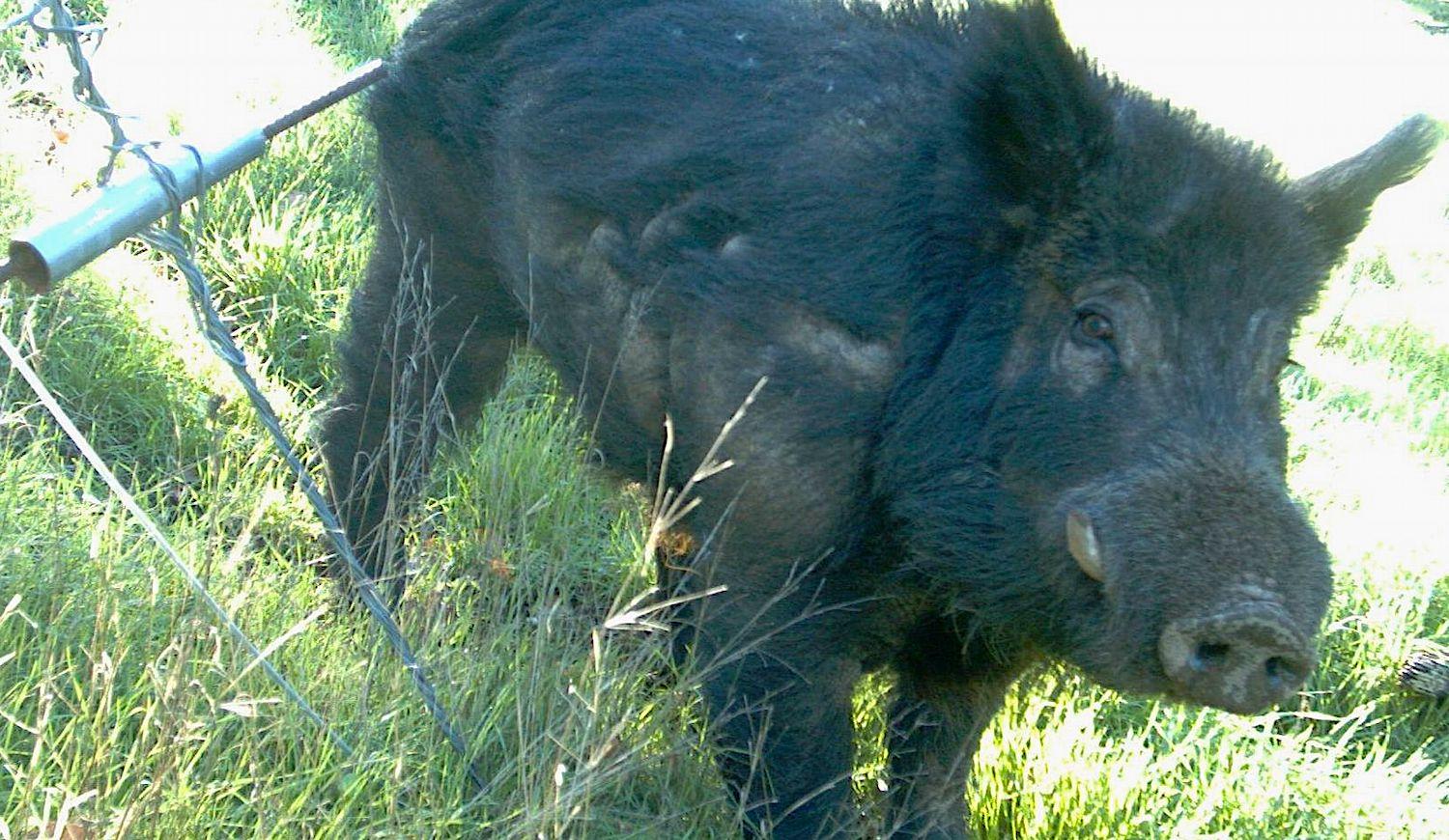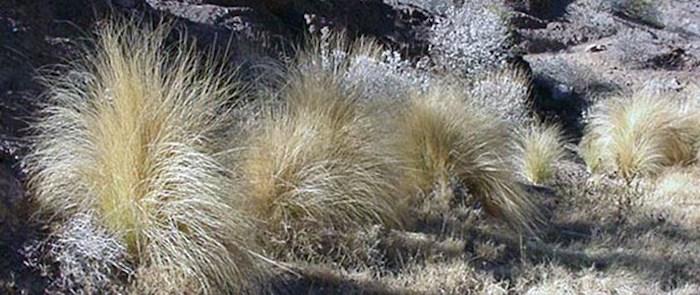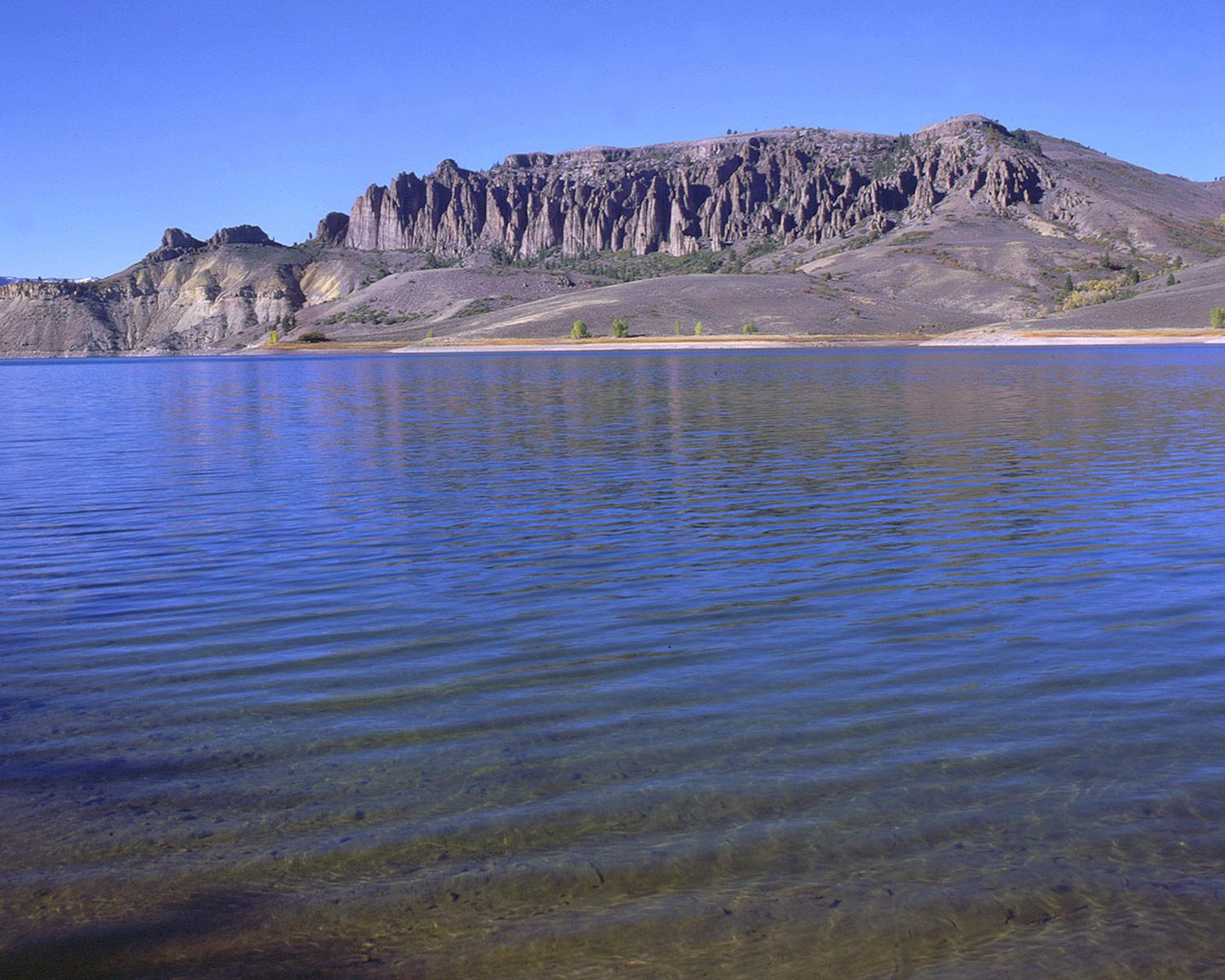
Aggressive efforts have almost eliminated feral hogs from Pinnacles National Park/NPS file
Traveler Special Report: Measuring Successes Against Invasive Species
By Lori Sonken
Editor's note: This is the latest article in a monthslong series of stories examining the issue of invasive species across the National Park System.
Feral pigs used to roam the chapparal and oak woodlands at Pinnacles National Park in California. Brought to the state in the 18th century to clear land, the pigs, weighing 100-200 pounds, rototilled through the soil and streams, killing salamanders, beetles, and aquatic invertebrates. In 2003, the park fenced out the pigs.
The solution worked flawlessly until this month.
Park staff spotted a juvenile pig exiting the park through a hole a coyote dug underneath the mesh wire fence. As of this writing, Pinnacles is relying on multiple cameras to spot other pigs, in addition to the monthly walks staff take to make sure the fence stays in good repair. Even with the breech, the park considers the fence effective. Now, there is less dispersal of nonnative plants, the park's oaks are regenerating, and the wetland habitat, important to the threatened California red-legged frog, is improving.
Circling Pinnacle's 24-mile-long perimeter, the 3.5-foot-high mesh fence allows other wildlife, including grey fox, desert cottontail, and mountain lions, to pass through or jump over. Based on an environmental assessment, the $3 million strategy recommended the installation of the fence and the eradication of 392 pigs inside the enclosure. The plan was deemed “the most ethically responsible alternative because it resulted in a finite number of pigs being euthanized,” said Paul Johnson, the park's wildlife biologist, in an email.
Across the country, there are examples of successful efforts to address the more than 4,500 nonnative species afflicting our national parks. But only a small percentage – about 10 percent of invasive animals and 3 percent of invasive plants -- are controlled. For those that are under control, human efforts supported by funding will likely be required forever.
Feral pigs also used to be a problem at Channel Islands National Park despite its location in the Pacific Ocean 22 miles from Santa Barbara, California. Arriving as domestic hogs in the 1850s, by the beginning of the 21st century they were widespread, rooting up native vegetation, creating erosion problems, spreading invasive weeds, and destroying archaeological sites.
In 2005, a company that specializes in removing nonnative animals from islands arrived to eliminate the pigs under a roughly $5 million plan developed by the National Park Service and The Nature Conservancy.

Ridding Channel Islands National Park of golden eagles was key in saving the island fox/Patrick Cone
The park also needed to address nonnative golden eagles, which moved to the islands when the endangered and native bald eagle disappeared. Initially drawn to the pigs, the golden eagles began consuming the native island fox, first on Santa Cruz and eventually also on Santa Rosa and San Miguel islands. The island fox population plummeted from 1,465 in 1994 to 62 in 2004 when the house-cat-sized animal was listed as endangered.
The Park Service’s solution involved relocating 40 golden eagles to the mainland, successfully returning the native Bald Eagle to the islands, and captively breeding and releasing the island fox. By 2016, the fox population had recovered and the species, which only lives in the Channel Islands, was delisted, said John Donoghue, acting chief of interpretation and public information officer.
There are other success stories across the National Park System. The population of burros roaming has declined, Yellowstone National Park officials believe they're making good headway in tamping down the population of nonnative lake trout in Yellowstone Lake, and hundreds of nonnative mountain goats have been hauled out of Olympic National Park.
But despite these success stories, about 90 percent of the approximately 1,400 reported invasive animal populations at more than 200 national parks are uncontrolled, according to Jessica Resnik’s 2018 report, Biodiversity Under Siege: Invasive Animals and the National Park Service.

Returning native bald eagles to Channel Islands National Park helped get the island fox off the Endangered Species List/NPS file
For invasive plants, the situation is more dire. As of 2017, only 43,000 of the more than 1.4 million acres of parklands infested with invasive plants were managed successfully. There are 17 invasive plant management teams devoted to controlling nonnative plants.
“Invasive plant management teams are like the hotshot crews of firefighters,” said Curt Deuser, supervisory ecologist, and liaison for the Lake Mead Inter-Regional Invasive Plant Management Team. Teams often work 10-hour-days for eight days in a row, often using chainsaws and herbicides.
“We’re controlling the weeds before they become further widespread,” said Deuser.
The Park Service counts limiting the spread of tamarisk and Russian olive trees in Death Valley, Joshua Tree, Zion, Bryce Canyon, and Arches national parks, and most of Capitol Reef National Park, as well as at Mojave National Preserve, on its success list. Both trees reduce native flora and fauna diversity. In addition, the tamarisk consumes large quantities of water needed for agricultural and urban uses.
Operating under a $300,000 annual budget, Deuser and his staff have removed Russian knapweed from Arches and Great Basin national parks, and bull thistle, also at Great Basin. His team prevented the fast-growing, drought-tolerant Sahara mustard that outcompetes native wildflowers from rooting permanently in Mojave National Preserve. The Park Service also is struggling to eliminate fountain grass from Joshua Tree National Park, but is managing the weed at Death Valley National Park and near Lake Mohave within the Lake Mead National Recreational Area.
“When you have a bad invasive plant, you have to stay on it all the time. If you skip a year, it’s like taking one step forward and two steps back," said Carrie Norman, a biologist at Lake Mead.
Since 2003, Park Service staff motor along the Lake Mohave shoreline in May when the fountaingrass is green and uptakes the herbicide, aquatic glyphosate (commerially known as Roundup). Working from boats, they use tank or backpack sprayers to douse the invasive species – a job now costing about $13,000 annually. As the fountain grass leaves the landscape, native purple awn is beginning to thrive.

It takes a lot of manpower to tackle fountaingrass in parks such as Lake Mead NRA and Saguaro National Park/NPS file
Without the work of the invasive plant management teams, parks would be subject to more wildfires due to the flammability of some nonnative grasses, there would be less diversity of native plants and wildlife, and the parks would be infested with weeds, said Deuser.
Saguaro National Park, home to the nation’s largest cacti growing up to 45-feet-tall in Tucson, Arizona, is successfully contending with buffelgrass, brought by the U.S. Soil Conservation Service in the 1930s to the Southwest as forage for animals and to control erosion. Now considered the archenemy of the Sonoran Desert, the weed is a fire hazard and outcompetes native plants, stealing their food, water, and sunlight.
The Park Service contracts with firms using helicopters to spray the weeds with herbicides. In addition, park staff and volunteers whack away the weeds with hand tools and sprayers. Their efforts have restricted the buffelgrass to about 2,000 acres of the 100,000 acre-park.
“We are reaching the point where we can see the light at the end of the tunnel for large efforts, but we will have some ongoing efforts forever,” said Jeff Conn, chief of science and resource management at Saguaro.
At Great Sand Dunes National Park and Preserve in Colorado, “we have had great success in eliminating the Canada thistle,” using targeted spraying along the Sand Ramp and Mosca Pass trails, said biologist Dewayne Mosher. Now, the trails look better and there are fewer opportunities for visitors in shorts to suffer thistle pricks. “If you ever touch a thistle, you only do it once on purpose,” said Mosher.
At Big Hole National Battlefield in Montana, prescribed burns help to keep the open hillslopes reminiscent of the 1877 Battle of the Big Hole. In addition, surveyors simultaneously identify and spray the invasive spotted knapweed, and note the whereabouts of the rare plant, Lemhi penstemon, using global positioning systems.
At first, Thomas Rodhouse, ecologist for the Upper Columbia Basin Inventory and Monitoring Network, was “concerned that this kind of double duty would disrupt our ability to survey plants.” But he says the plan is “wildly successful” at reducing the knapweed.
He suspects one reason for the success may be that the botanists visit new areas randomly selected through a statistical process, instead of areas where they suspect the weed resides. “We are overcoming the human tendency to shy off certain areas,” such as steep, awkward locations to reach. The approach is working and may be a strategy worth considering in other locations, Rodhouse said.

A stringent monitoring program so far has kept quagga and zebra mussels out of Curecanti National Recreation Area/NPS, Lisa Lynch
The Park Service has kept quagga and zebra mussels out of Curecanti National Recreation Area in Colorado. This is because Colorado requires inspections of all motorized and trailed watercraft for aquatic invasive species prior to launch. In contrast, the mussels have invaded waters in Kansas, Missouri, Arizona, Texas, Oklahoma, and Utah.
Bill Bruggeman, aquatic invasive species coordinator and supervisory park ranger at Curecanti, expects boat inspections will continue forever. “My hope is that some smart kids out there look at DNA and chain sequencing and someone comes up with a biological success story” to eliminate the mussels, he said.
Aside from monitoring and eradicating invasive species, education is important. Marcus Key, biologist, and assistant coordinator for the Great Lakes Restoration Initiative, helped install posters and boot brush stations with seed collectors at 10 parks, including Sleeping Bear Dunes, Indiana Dunes, and Isle Royale. The posters discuss the importance of cleaning one’s boots before entering and leaving trailheads to stop the spread of non-native species. Next to the posters are boot brushes for hikers to use.
“The seed collection trays have invasive species growing out of them, if they are not shoveled out," said Key. “I would love to say they are working, but as a scientist it’s hard to say definitively. As an educator I can say, they are definitely working to raise awareness of the issue.”
Key recalls how parks used to remind visitors to take nothing but photos and leave only footprints. Now, he says, even footprints can be dangerous.
Previous articles in this series on invasive species in the National Park System:
Traveler Special Report: The Invasion Of The National Park System
Traveler Special Report: The Cost Of Invasive Species In The National Park System
Traveler Special Report: Vegetative Invaders In The National Parks
Charitable Dollars Help In Fight Against Invasives In National Park System
Invasive Fish in National Parks | Voracious, deadly invaders ply national park waters

Comments
Invasive Species are interesting. I believe that we can only control and not truly eliminate these invasives. I live in Texas and we deal with the invasive red fire ant that was accidentally imported to the Southern United States in the 1930's. I have tried everything to get rid of these little beasties and they always come back in a vengeance once it rains (the red fire ant bites are painful as well). "Texas Monthly" has recently written a great article concerning these imported red fire ants. The reason I bring this up is invasives can be contained, but can they truly be eliminated? We can restore, but to bring back the environment to a pre-columbian environment is not realistic. Look at the dam removals going on across America. These dam removals are beneficial, but the affected environs dont truly revert back to what once was. Final note: I believe the only thing that will get rid of the imported red fire ants is a massive ice age that lasts for years in the Southern States.